
Eucalyptus is a genus of more than 700 species of flowering plants in the family Myrtaceae. Most species of Eucalyptus are trees, often mallees, and a few are shrubs. Along with several other genera in the tribe Eucalypteae, including Corymbia and Angophora, they are commonly known as eucalypts or "gum trees". Plants in the genus Eucalyptus have bark that is either smooth, fibrous, hard, or stringy and leaves that have oil glands. The sepals and petals are fused to form a "cap" or operculum over the stamens, hence the name from Greek eû ("well") and kaluptós ("covered"). The fruit is a woody capsule commonly referred to as a "gumnut".

Opodiphthera eucalypti, the emperor gum moth, is a species of moth in the family Saturniidae native to Australia. This species was formerly placed in the genus Antheraea.
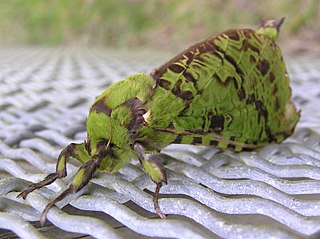
Aenetus is a genus of moths of the family Hepialidae. There are 24 described species found in Indonesia, New Guinea, New Caledonia, Australia and New Zealand. Most species have green or blue forewings and reddish hindwings, but some are predominantly brown or white. The larvae feed in the trunks of living trees, burrowing horizontally into the trunk, then vertically down.

Thaumetopoeinae is a subfamily of moths in the family Notodontidae. This group is sometimes treated as a family Thaumetopoeidae with three subfamilies: Thaumetopoeinae, Anaphinae and Epicominae. However, it is now commonly treated at subfamily rank based on morphological and molecular phylogenetic evidence.
William Baxter was an English gardener who collected in Australia on behalf of English nurserymen and private individuals. He had developed his horticultural reputation as gardener to the Comtesse de Vandes in Bayswater, London, many of the plants he had nurtured being used for illustrations in Curtis's Botanical Magazine. He was the first privately financed plant collector to be sent to Australia, his mission being to collect seeds and roots for the London seedsman F. Henchman.

Eucalyptus macrocarpa, commonly known as mottlecah, is a species of mallee that is endemic to the south-west of Western Australia. It has smooth bark, usually sessile, heart-shaped adult leaves arranged in opposite pairs, large red flowers and broad conical fruit.
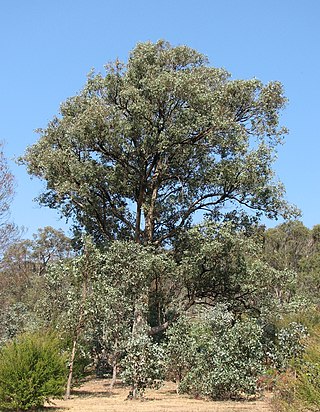
Eucalyptus polyanthemos, commonly known as red box, is a species of small to medium-sized tree, that is native to eastern Australia but has been introduced into other countries. It has fibrous bark on the trunk and larger branches, smooth greyish to cream-coloured bark above, or smooth bark throughout. It has broadly egg-shaped to round juvenile leaves, lance-shaped, egg-shaped or almost round adult leaves, flower buds in groups of seven, white flowers and barrel-shaped to conical fruit.

The Nacophorini are one of the smaller tribes of geometer moths in the subfamily Ennominae. They are the most diverse Ennominae of Australia and are widespread in the Americas. If the African genera tentatively placed herein indeed belong here, the distribution of the Nacophorini is distinctly Gondwanan, with their probable origin either of Australia, South America or even Antarctica. In Eurasia, they are rare by comparison.

Mnesampela privata, the autumn gum moth, is a moth of the family Geometridae. The species was first described by Achille Guenée in 1858. It is found in most of Australia.
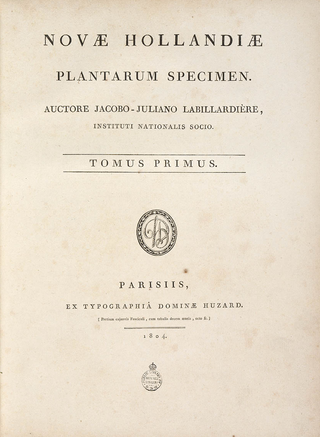
Novae Hollandiae Plantarum Specimen is a two-volume work describing the flora of Australia. Facsimiles of the originals can be found in the online Biodiversity Heritage Library (Vol.1) and Vol 2).

Abantiades atripalpis, also known as bardee grub, rain moth or waikerie, and previously known as Trictena atripalpis, is a moth of the family Hepialidae. It is found in the whole southern half of Australia.

Abantiades latipennis, known as the Pindi moth, is a species of moth in the family Hepialidae. It may also be referred to as a swift moth or a ghost moth, as this is a common name associated with Hepialidae. Endemic to Australia and identified in 1932, it is most populous in temperate rainforest where eucalypti are prevalent, as the larvae feed primarily on the roots of these trees. Females lay eggs during flight in a scattering fashion. The larvae live for over eighteen months underground, while adult moths survive for approximately one week, as they have no mouthparts with which to feed. The moths are preyed upon by a number of predators, including bats and owls. Brown in colour overall, males are paler and the identifying silver bars of the male's wings are more prominent than those of the female's, with dark margins. Male adults are generally smaller.
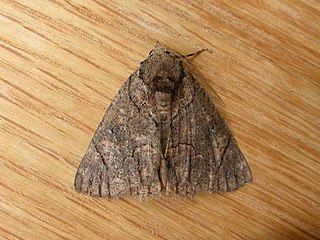
Heliomystis is a monotypic moth genus in the family Geometridae. Its only species, Heliomystis electrica, the electric moth, is found in the southern half of Australia. Both the genus and species were first described by Edward Meyrick in 1888.

Euclemensia woodiella, the Manchester tinea, is a yellow and brown British moth. It is regarded as extinct, and is known from only three museum specimens, one of which is held by the Manchester Museum, one by the Natural History Museum, London, and the type, which is in the Curtis Collection at Museum Victoria.
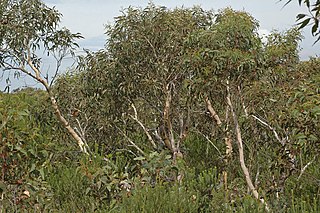
Eucalyptus racemosa, commonly known as snappy gum or narrow-leaved scribbly gum, is a species of small to medium-sized tree that is endemic to eastern Australia. It has smooth, mottled bark, lance-shaped to curved or egg-shaped adult leaves, flower buds in groups of between seven and fifteen, white flowers and cup-shaped, conical or hemispherical fruit.
Hestiochora occidentalis is a moth of the family Zygaenidae. It is endemic to the temperate parts of Western Australia.
Ogmograptis scribula, the scribbly gum moth, is a moth of the family Bucculatricidae. It is found in the Australian Capital Territory, New South Wales and Queensland. It is responsible for producing 'scribbles' found of multiple species of Eucalypts, creating the pattern from which its name is derived.
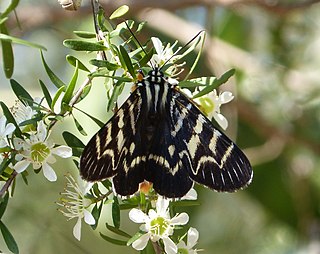
Comocrus is a monotypic moth genus in the family Noctuidae erected by Karl Jordan in 1896. Its only species, Comocrus behri, the mistletoe moth or mistletoe day moth, was first described by George French Angas in 1847. It is widely distributed in southern Australia from Perth to Melbourne and adjacent to Bass Strait, occurring as far north as Derby, Western Australia, and Clermont and Rockhampton in Queensland. It may be seen during daylight hours hovering around mistletoe species such as Amyema miquelii, Amyema melaleucae and Amyema cambadgei growing on Casuarina and Eucalyptus trees. The adult moths feed on Eucalyptus flower nectar, have a wingspan of some 58 millimetres and are basically black with white bands running through the wings. Individuals ready to mate exhibit 'hill-topping' behaviour, flying to high points in the landscape and there encountering mates.
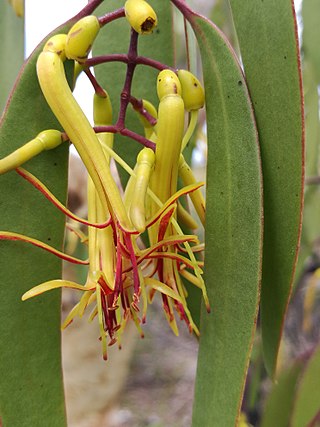
Muellerina eucalyptoides, commonly known as creeping mistletoe, is a hemiparasitic aerial shrub in the family Loranthaceae. The species is endemic to Australia.


















